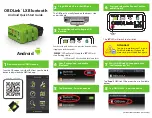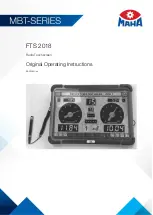
© 2018 Valeport Ltd
Installation
Page 11
3. Installation
The MIDAS CTD+ system is supplied in an ABS transit case, together with any communications
adaptors ordered. Any additional lengths of signal cable are packed separately.
3.1. Communications With PC
The MIDAS CTD+ can be set up and interrogated using the DataLog Pro software supplied. Please
refer to separate manual for details of how to use the software.
To connect the instrument directly to a PC for RS232 communications, use the 3m Y lead supplied.
This lead is fitted with a 10 pin SubConn type connector, which should be plugged directly into the
connector on the top of the housing (or to a length of signal cable). The lead also features 2 x 4mm
banana plugs for application of external power if required and a 9 way D type connector which
should plug directly into a spare comm port on the back of the PC.
If non-RS232 communications are to be used, via the optional RS485, RS422 or FSK methods, then
the appropriate adaptor should be used. Each adaptor is supplied with a switched 3m Y lead
(different to the standard RS232 Y lead), which should be connected as follows:
Comms
Method
Adaptor
Part no.
Connections
RS485
0400029
Connect 15 pin D type and 4mm plugs from Y lead into adaptor.
Connect 9 pin D type from adaptor to PC, and 4mm plugs from adaptor
to external power, as indicated on adaptor housing.
RS422
0400030
Connect 15 pin D type and 4mm plugs from Y lead into adaptor.
Connect 9 pin D type from adaptor to PC, and 4mm plugs from adaptor
to external power, as indicated on adaptor housing.
FSK
0400005
Connect 4mm plugs from Y lead into adaptor, leaving D types
unconnected (FSK uses power and signal on just two wires). Connect 9
pin D type from adaptor to PC, and 4mm plugs from adaptor to external
power, as indicated on adaptor
3.2. Deploying the MIDAS CTD+ on its Own
All parts of the standard system (with the exception of the top part of the 3m Y lead) are designed for
immersion. All communications adaptors (RS485, RS422, FSK) are splash proof, but should be sited in
a dry place, as close to the PC as possible.
The MIDAS CTD+ is supplied with a stainless steel protective cage, but care should still be taken not
to damage the instrument. For profiling work, the recommended deployment method is to suspend
the instrument using the stainless steel wire strop. For fixed deployments, the user may wish to
remove the steel cage, and use the grooves in the titanium instrument housing as clamping points.












































